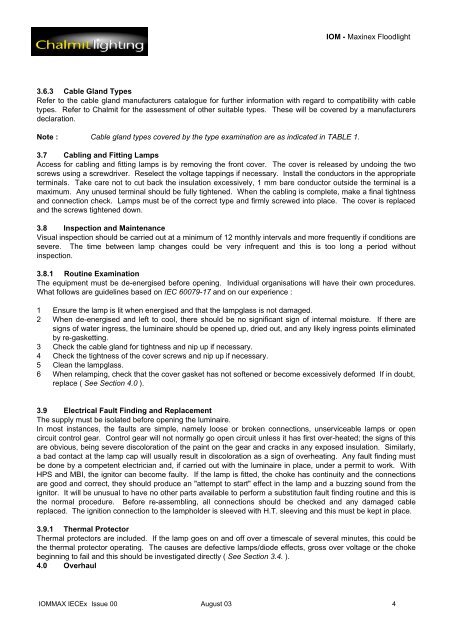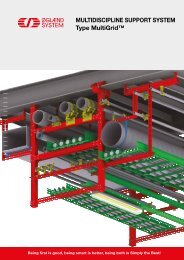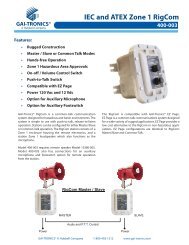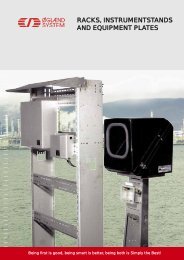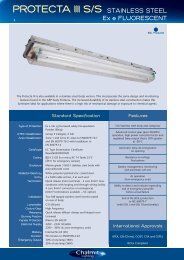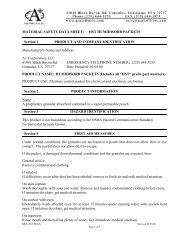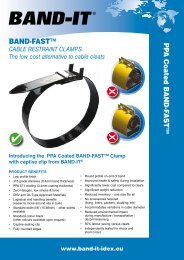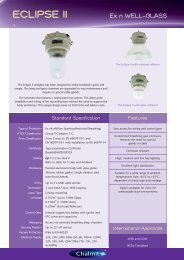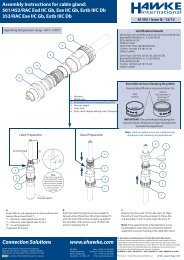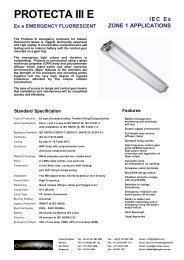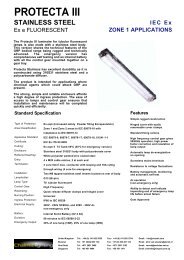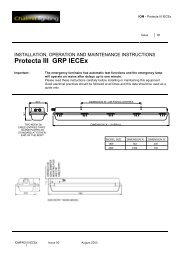IOM - Maxinex - JT Day Pty Ltd
IOM - Maxinex - JT Day Pty Ltd
IOM - Maxinex - JT Day Pty Ltd
Create successful ePaper yourself
Turn your PDF publications into a flip-book with our unique Google optimized e-Paper software.
<strong>IOM</strong> - <strong>Maxinex</strong> Floodlight<br />
3.6.3 Cable Gland Types<br />
Refer to the cable gland manufacturers catalogue for further information with regard to compatibility with cable<br />
types. Refer to Chalmit for the assessment of other suitable types. These will be covered by a manufacturers<br />
declaration.<br />
Note : Cable gland types covered by the type examination are as indicated in TABLE 1.<br />
3.7 Cabling and Fitting Lamps<br />
Access for cabling and fitting lamps is by removing the front cover. The cover is released by undoing the two<br />
screws using a screwdriver. Reselect the voltage tappings if necessary. Install the conductors in the appropriate<br />
terminals. Take care not to cut back the insulation excessively, 1 mm bare conductor outside the terminal is a<br />
maximum. Any unused terminal should be fully tightened. When the cabling is complete, make a final tightness<br />
and connection check. Lamps must be of the correct type and firmly screwed into place. The cover is replaced<br />
and the screws tightened down.<br />
3.8 Inspection and Maintenance<br />
Visual inspection should be carried out at a minimum of 12 monthly intervals and more frequently if conditions are<br />
severe. The time between lamp changes could be very infrequent and this is too long a period without<br />
inspection.<br />
3.8.1 Routine Examination<br />
The equipment must be de-energised before opening. Individual organisations will have their own procedures.<br />
What follows are guidelines based on IEC 60079-17 and on our experience :<br />
1 Ensure the lamp is lit when energised and that the lampglass is not damaged.<br />
2 When de-energised and left to cool, there should be no significant sign of internal moisture. If there are<br />
signs of water ingress, the luminaire should be opened up, dried out, and any likely ingress points eliminated<br />
by re-gasketting.<br />
3 Check the cable gland for tightness and nip up if necessary.<br />
4 Check the tightness of the cover screws and nip up if necessary.<br />
5 Clean the lampglass.<br />
6 When relamping, check that the cover gasket has not softened or become excessively deformed If in doubt,<br />
replace ( See Section 4.0 ).<br />
3.9 Electrical Fault Finding and Replacement<br />
The supply must be isolated before opening the luminaire.<br />
In most instances, the faults are simple, namely loose or broken connections, unserviceable lamps or open<br />
circuit control gear. Control gear will not normally go open circuit unless it has first over-heated; the signs of this<br />
are obvious, being severe discoloration of the paint on the gear and cracks in any exposed insulation. Similarly,<br />
a bad contact at the lamp cap will usually result in discoloration as a sign of overheating. Any fault finding must<br />
be done by a competent electrician and, if carried out with the luminaire in place, under a permit to work. With<br />
HPS and MBI, the ignitor can become faulty. If the lamp is fitted, the choke has continuity and the connections<br />
are good and correct, they should produce an "attempt to start" effect in the lamp and a buzzing sound from the<br />
ignitor. It will be unusual to have no other parts available to perform a substitution fault finding routine and this is<br />
the normal procedure. Before re-assembling, all connections should be checked and any damaged cable<br />
replaced. The ignition connection to the lampholder is sleeved with H.T. sleeving and this must be kept in place.<br />
3.9.1 Thermal Protector<br />
Thermal protectors are included. If the lamp goes on and off over a timescale of several minutes, this could be<br />
the thermal protector operating. The causes are defective lamps/diode effects, gross over voltage or the choke<br />
beginning to fail and this should be investigated directly ( See Section 3.4. ).<br />
4.0 Overhaul<br />
<strong>IOM</strong>MAX IECEx Issue 00 August 03 4


